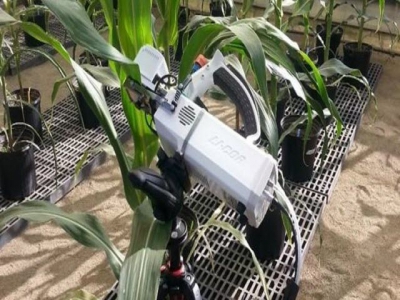Breeding corn for water use efficiency may have gotten easier

Researchers develop new method to screen plants for water use efficiency without need for time-consuming field measurements.
Water-use efficiency measurements traditionally require specialized equipment, shown here, and are time consuming. Tony Studer's method speeds up the process significantly.
With approximately 80% of the U.S. water supply going toward agriculture, and in a climate with less predictable rainfall patterns and more intense droughts, researchers at the University of Illinois are working to reduce water consumption by developing more efficient crops.
"There's a study from many decades ago that shows the amount of water transpired and lost to the air in an acre of corn is 3,000-4,000 gal. per day. At 90 million acres of corn in the U.S., plus the length of the growing season, that's lots and lots of water. So, there are a lot of improvements that need to be made," said Tony Studer, assistant professor in the University of Illinois department of crop sciences and author of a new study in The Plant Journal.
A previous study from Studer's group suggested that corn could become 10-20% more efficient through breeding improvements, which means that plants would be less stressed during short-term droughts. Theoretically, this could add protection for farmers, given uncertain weather patterns. However, to make that a reality, the breeding process itself needs to become more efficient, Studer said.
When attempting to improve a certain trait, in this case water use efficiency, breeders grow a diverse set of corn lines and screen them to find natural variation in the trait. Once they identify promising individuals, breeders then try to locate key genes that will amplify the trait or integrate the trait into lines of corn with additional desirable qualities.
"It takes a lot of time, space and effort to produce a productive hybrid," Studer said.
Water use efficiency is typically measured with an instrument that clamps to leaves and monitors the flux of carbon dioxide and water vapor moving into and out of the leaf. This process is time consuming and expensive at large scales, as each measurement can take over an hour, the university said.
"If you're going to study water use in a breeding environment or in a field at scale, you need something faster," Studer said.
In their current study, Studer and his colleagues developed a new method to screen hundreds or even thousands of plants without the need for time-consuming field measurements. The method, which tests leaf samples in the lab, takes advantage of the fact that the carbon in carbon dioxide exists in two forms in the atmosphere: a more-abundant and lighter form, 12C, and a less-abundant and heavier form, 13C.
Once carbon dioxide enters plant leaves, the carbon is incorporated into sugars and plant tissues. Scientists can then measure how much 13C was incorporated compared to 12C. For many plants, the 12C-to-13C ratio is indicative of their water use efficiency, but until now, scientists didn't know if the ratio could reliably reflect water status in corn. Studer said his study shows that it can.
"We found significant variation in the 12C:13C ratio across 36 diverse lines of corn, and the 12C:13C signature is heritable across environments," he said. "Proving that a trait is inherited and expressed across environments allows a plant breeder to select for this trait and is essential when developing new lines."
The finding, derived from controlled greenhouse trials as well as three field seasons, provides the efficient method Studer was looking for, and it shows that inbred lines whose carbon ratios are within a certain range may have greater water use efficiency, although it's too early to say how this will play out in hybrids, the university explained. Right now, it's enough that the trait appears to be heritable — which in and of itself will be a great help to breeders — but Studer has plans for the next steps.
"In a past study, we found there's room for improvement in corn's water use efficiency. Here, we're showing that the trait is measurable and heritable, and we can actually use it to try to make improvements," he said. "The next step is identifying the genes in these regions of the genome that we can manipulate. We've moved all the way from a basic idea of developing the science behind these traits to the point where we can actually make improvements." n
Related news
 Good management in planning and producing, improving the quality of grapefruit products
Good management in planning and producing, improving the quality of grapefruit products 55 hectares are newly planted, the planted area of from 1 to 3 years is 596.8 hectares, the area for harvesting is 395 hectares.
 Tin Nghia puts coffee processing plant into service
Tin Nghia puts coffee processing plant into service Dong Nai Province-based Tin Nghia Coffee Company has put into operation an instant coffee processing plant, with total investment capital of US$100 million
 NESCAFÉ promotes Vietnamese coffee to the world
NESCAFÉ promotes Vietnamese coffee to the world In order to promote and develop Vietnamese coffee to the world, Nestlé Vietnam has organised a trip for international journalists to visit the sustainable coffe